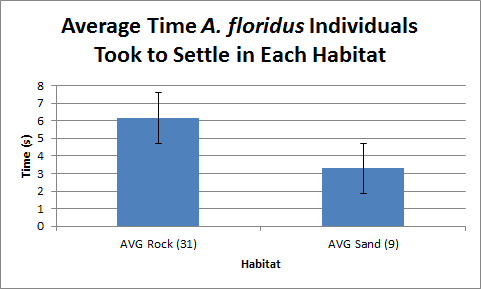Life History & Behaviour
A small experiment had been done to determine the behavioural aspects of the species Atergatis floridus.
Four Atergatis floridus specimens were gathered in the lab from Moreton Bay, Queensland, Australia, and they were tested for preference in habitat. As stated in the Ecology page, this species tend to live in crevices of dead coral or rocks for hiding purposes, and thus was hypothesised that they preferred to settle in rocky coral areas rather than open sandy areas. It was therefore expected that the crabs would move faster towards the rocky habitat, and slower when settling in sandy habitats.
The experiment was undertaken in the lab with a large Tupperware container which had two mimic environments on each side. The container had a layer of sand, empty on one side, and filled with rocks and coral on the opposite, then filled with seawater. An individual was placed in the middle of the container to see which way it moved towards. Each crab had 10 trials, and there were 4 different individuals, therefore a set of 40 data. The time was taken from when the crab was placed in the middle of the container, until they had chosen a place to settle. In order to determine if it was truly where the crab had settled, the individual had to stay still for 20 seconds after the initial movement in order for the trial to count. Therefore, wherever they settled for over 20 seconds, it was counted as the preferred habitat. Food pellets were placed on each side of the container to enhance the activity of the crabs. The average time was taken for each rocky or sandy habitat, as well as the number of times each habitat was preferred. A T-test was done to determine the significance of the difference in times.
The bar graph in figure 5 below shows the final result of the experiment.

Figure 5. The bar graph depicting the final results.
This graph demonstrates that the trials where the crabs chose rock habitats took longer, and the time it took for the crabs to settle in a sand habitat was shorter. There were a total of 31 trials where the specimen chose to settle on the rocky habitat, and a total of 9 where a sandy habitat was chosen. A two-tailed T-test for the two data sets was taken with a p-value of 0.019813 which shows significance.
The hypothesis was not accepted since the average time it took for the crabs to settle in the rocky habitat was longer than of sandy habitats. The main suspected reason may be that when the individuals were placed in a new environment, they tended to move around the container for a while before settling. On some trials, the crabs went straight for the rocky habitat, and stayed there, but in other cases, they went towards the sandy, but did not settle while moving around and eventually settling at the rocky habitat. The total number of trials where crabs settled on the rocky habitat suggests that it is the preferred habitat, but the time it took for them to settle did not seem to determine preference. On the other hand, the data suggests that the crabs could not settle on sandy habitats as frequent as the rocky counterpart, which, indirectly proposes that the crabs do not feel comfortable in sandy open areas, and were tempted to move into the rocky covered habitat where they are capable of blending in. However, note that the crabs were engaged in the movement of the containers, therefore anthropogenic stress may have affected the results greatly.
|